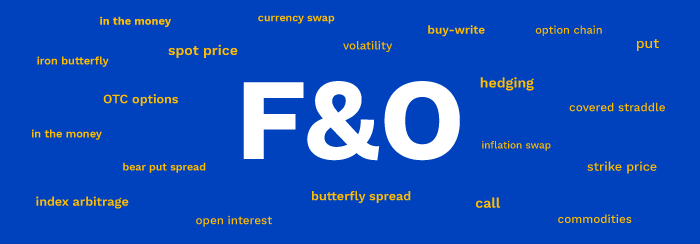In financial markets, trading is not just about buying and selling shares. It also involves more complex instruments like futures and options, collectively known as F&O trading.
These derivatives are powerful tools traders use to hedge risk, speculate on price movements, or enhance portfolio returns. But with the potential for high rewards comes increased risk, especially for beginners.
This article will provide a detailed breakdown of F&O trading, how it works, popular strategies, associated risks, and the potential rewards for those who trade wisely.
What Is F&O Trading?

F&O stands for Futures and Options, two derivative instruments whose value is derived from an underlying asset like stocks, indices, commodities, or currencies. These contracts allow traders to speculate on the underlying asset's price without owning it.
What Are Futures?
A futures contract is a legal agreement to buy or sell an asset at a predetermined price on a specified future date. It is standardised and traded on an exchange, meaning both parties agree to the price today, but the transaction is executed in the future.
Traders use futures to speculate on price movements or hedge against potential price fluctuations in their holdings. Futures trading is available for many assets, including stock indices, commodities like gold and crude oil, and currencies.
What Are Options?
An option contract gives the buyer the right, but not the obligation, to buy or sell an asset at a specific price before a specified date. There are two types of options:
Unlike futures, where both buyer and seller are obligated, options provide flexibility. However, buyers pay a premium for this benefit.
Key Differences Between Futures and Options
While both are derivatives, futures and options differ in several ways:
Obligation vs. Right: Futures obligate both parties to transact on expiry. Options provide a right but not an obligation.
Premium Payment: Options buyers pay a premium upfront; futures require margin deposits.
Risk Exposure: Futures carry unlimited risk and reward. Options limit the buyer's loss to the premium paid.
Profit Potential: Futures can be more profitable in strong directional moves. Options are strategic for various market conditions, including flat or sideways markets.
How F&O Trading Works
F&O contracts are traded on CME or NYSE in the United States. Contracts are standardised with expiry dates, lot sizes, and settlement mechanisms.
Each F&O contract has:
Underlying Asset: The stock, index, or commodity it is based on
Lot Size: The minimum quantity you can trade
Strike Price: For options, the price at which the asset can be bought or sold
Expiry Date: The date on which the contract expires
These characteristics make F&O trading attractive to institutional investors and retail traders seeking flexibility and leverage.
Common F&O Trading Strategies

Traders use several F&O strategies depending on their risk appetite, market outlook, and goals. Below are some widely adopted methods:
1. Hedging
Hedging involves using F&O contracts to offset potential losses in an existing position. For example, if you own shares of a company and fear a short-term drop in price, a put option can limit downside risk.
2. Speculation
Speculators use F&O contracts to bet on future price movements. Futures are used for aggressive directional bets, while options allow for strategic trades based on volatility and price levels.
3. Covered Call Writing
This is a conservative strategy where an investor sells a call option while holding the underlying stock. The aim is to earn the premium while potentially selling the stock at a higher price.
4. Protective Puts
Buying a put option while holding a long stock position helps protect against downside risk. It's like an insurance policy on your portfolio.
5. Straddles and Strangles
These are volatility-based strategies using options:
Both strategies profit from large price movements in either direction.
6. Calendar Spreads
This involves buying and selling options with the same strike price but different expiration dates. It's used to profit from time decay and volatility differences.
Tips for Beginners
If you're new to F&O trading, here are a few key tips to keep in mind:
Start small: Use minimum lots and avoid aggressive leverage until you gain confidence.
Educate yourself: Take online courses or read reputable books to understand the mechanics.
Use stop-loss orders: Always define your risk on every trade to avoid massive losses.
Track news and data: F&O markets react quickly to macroeconomic events.
Avoid overtrading: Trading frequently without a clear strategy can lead to quick losses.
Paper trade: Practice in a simulated environment before using real capital.
Risks and Rewards
While F&O trading offers immense potential, it is not without significant risks. Understanding these risks is crucial for any trader.
1. Leverage Risk
F&O contracts require only a margin deposit to control a large position. This leverage can amplify both profits and losses. A small adverse move can wipe out your capital quickly.
2. Market Volatility
F&O instruments are sensitive to market volatility. Sudden news events, economic data, or geopolitical tensions can result in sharp price swings, increasing risks.
3. Time Decay in Options
Options lose value over time, a phenomenon known as theta decay. If the market does not move in the expected direction within a set time frame, the option may expire worthless.
4. Complexity
F&O trading involves a steep learning curve. Misunderstanding contract terms, expiry rules, or Margin Requirements can lead to losses.
5. Liquidity Risk
Not all F&O contracts are highly liquid. Low-volume contracts can have wide bid-ask spreads, making it hard to enter or exit positions at desired prices.
6. Margin Calls
Futures contracts require daily mark-to-market settlements. If the market moves against your position, you may be required to deposit more money (margin call) or risk having your position squared off by the broker.
Rewards
1. High Return Potential
Due to leverage, small movements in the underlying asset can lead to significant profits, especially in futures trading.
2. Portfolio Protection
Options are excellent tools for protecting investments. Hedging with puts can save investors from massive losses during market downturns.
3. Flexibility
F&O contracts can be tailored to a variety of market scenarios. Whether bullish, bearish, or neutral, there's a strategy to match.
4. Income Generation
Strategies like covered calls can generate consistent income, making them attractive for conservative traders.
5. Enhanced Liquidity
Most major indices and stocks have actively traded F&O contracts, allowing traders to enter and exit positions quickly.
Conclusion
In conclusion, F&O trading is a sophisticated and effective way to participate in financial markets. Whether you're a beginner looking to understand the basics or a seasoned investor considering derivatives, approaching F&O trading with caution, discipline, and ongoing education is key.
By managing risks and applying well-thought-out strategies, you can harness the potential of F&O trading while avoiding its many pitfalls.
Disclaimer: This material is for general information purposes only and is not intended as (and should not be considered to be) financial, investment or other advice on which reliance should be placed. No opinion given in the material constitutes a recommendation by EBC or the author that any particular investment, security, transaction or investment strategy is suitable for any specific person.








